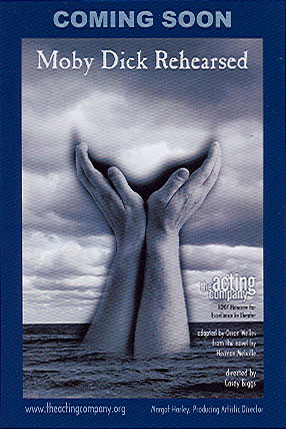The other event of our non-fiber-arts arts weekend was this…

… The Acting Company‘s production of Orson Welles’ Moby Dick Rehearsed.
We stumbled on this performance just by luck. I often listen on-line to San Francisco’s big classical music radio station KDFC while I while I work in my office. I don’t pay it much attention, particularly not when commercials are on, but during the mutter-mutter-mutter of one commercial, I caught the words “Moby Dick.”
Now Moby Dick does not mean that much to me. I’ve never read the novel, though I do have fond memories of my family watching the Gregory Peck film version together on tv when I was a kid. (The trailer and a newsreel clip of Gregory Peck at the film’s opening on YouTube.) But Melissa loves, loves, loves the novel and is always glad to encounter new interpretations of it. So the next time I heard the mumble of commercials start up again, I actually listened.
Ten minutes and some quick on-line shopping later, Melissa and I had tickets to this production.
Orson Welles worked with Melville’s story a number of times in his life. He wrote and performed in Moby Dick Rehearsed, then did a Bristish television version of the novel (there’s speculation that this was actually a production of Moby Dick Rehearsed, but no copy of it seems to have survived), played the key role of the preacher shortly afterward in the film, and near the end of his life he’d begun filming himself reading the novel. (Clips—with Italian subtitles—on YouTube here and here.)
The central conceit of Moby Dick Rehearsed, which is set in the mid-19th Century, is that a traveling group of actors performing King Lear has been convinced by one of its members to spend an afternoon doing a reading based on the novel, which he’s taken a fancy to. The young actor plays Ishmael. The imperious actor/manager who runs the troupe takes on—of course—the role of Ahab.
The promos for the play made it sound as if the two narratives—King Lear and Moby Dick—were woven together to create a more complicated, composite text, but this really wasn’t the case. Once the troupe begins the reading of Moby Dick, they remain in these characters, until the very end of the play, when they step back out of their roles.
The acting itself felt rough as fist, the 19th Century players a group involving all the usual theatrical stereotypes: an egomaniac, a “serious” actor, an ingenue, a drunkard, and so forth. I had a hideous moment of thinking, “I laid out how much for these tickets?” Then the actors began the reading of Moby Dick, and Melissa and I were both riveted. At the moment when the actor perched atop a ladder that stood in for a crow’s nest boomed out “Thar she blows!,” I knew I’d gotten my money’s worth. The ocean was real, the whale was real, the crew were real. Ahab walked on two legs, but the cane he held in front of one of them felt as real as any more elaborate peg-leg get-up could have. The black boxes on rollers and ladders transformed back and forth between shore and ship easily.
I’m pestering Melissa now to put the film Moby Dick into her Netflix queue. I want to compare it both to this production and to my memories of seeing it forty-odd years ago.

that sounds like it was fun. We used to go to plays all the time in Ohio. there was a group that did it during the summer and it was always so much fun. When I was younger, growing up in Germany, our whole class would go to the theater, the really fancy ones to watch all sorts of plays. I used to love it. They do get quite expensive nowadays though :o(